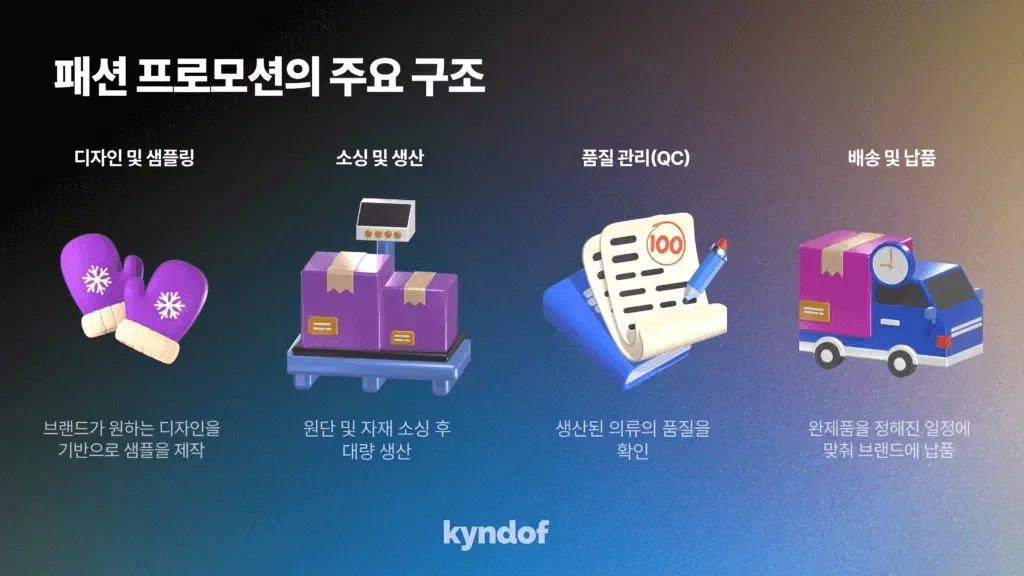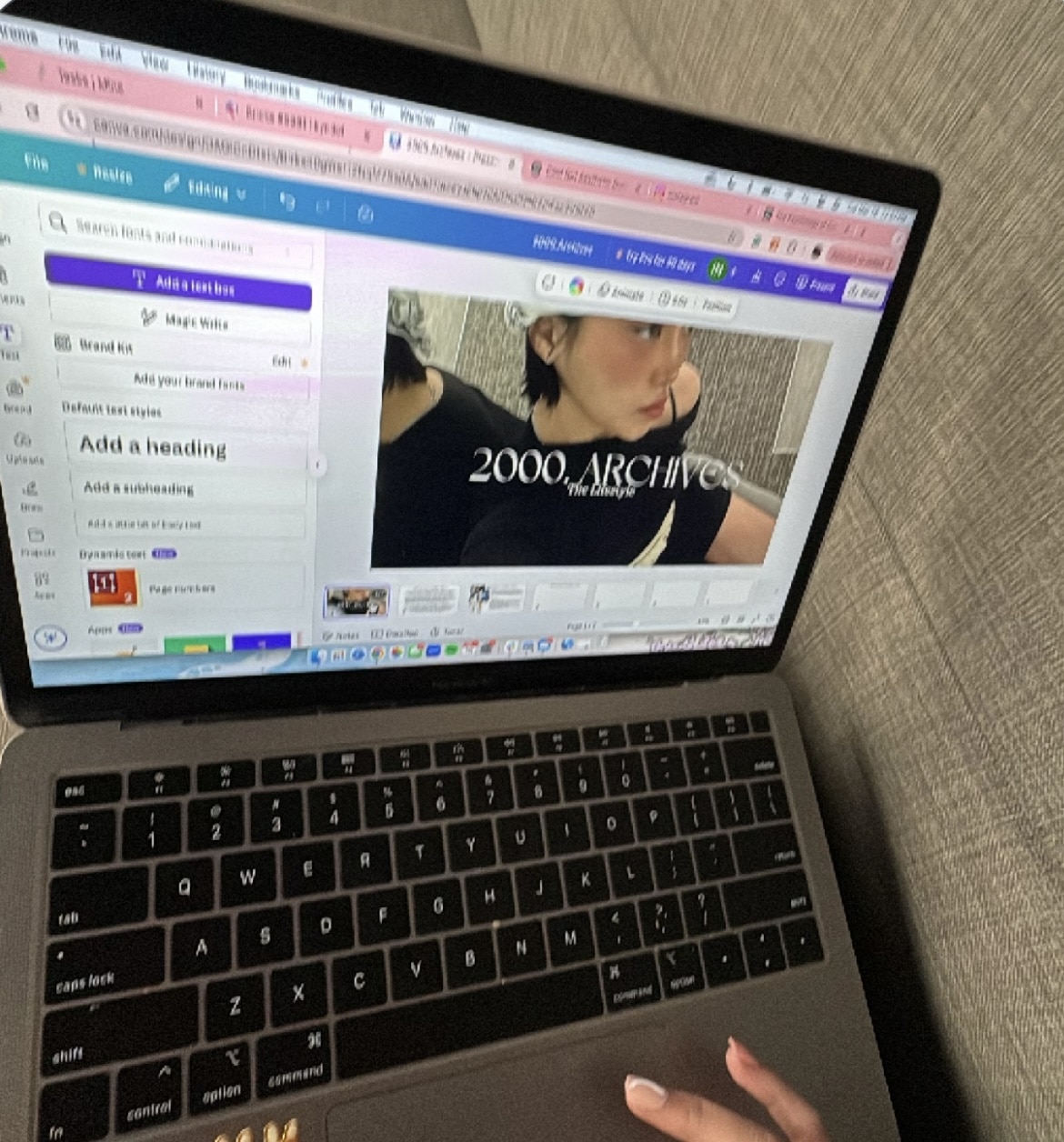1. Introduction : Current Status of Fashion Promotion in Korea
The Korean fashion industry continues to grow rapidly and is expanding its influence not only domestically but also in the global market. Accordingly, fashion brands are actively considering overseas production, production in China, etc., rather than simply relying on domestic production. Fashion promotion is generally a service that handles all stages of the clothing production process, and here, it means promotion that focuses on clothing production and supply chain management rather than marketing.
2. Definition of fashion promotion
Fashion promotion refers to a service that handles the entire process of clothing production. Unlike marketing promotion, it includes all processes from clothing design, sample production, mass production, quality control, and delivery. This allows fashion brands to reduce the burden of the production process and focus on design and marketing.
3. The main structure of fashion promotions

Garment production outsourcing is broken down into the following steps
- 1. Design and sampling : Create samples based on the brand’s desired design.
- 2. Sourcing and production : sourcing fabrics and materials and then mass production.
- 3. Quality control (QC) : Checking the quality of the garments produced and reviewing that they meet the requirements.
- 4. Shipping and delivery : delivering the finished product to the brand on schedule.
4. Roles and responsibilities of garment production agencies
Apparel production agencies take on the following roles to deliver the results brands want:
- – Design sourcing and collaboration : Collaborating with designers to bring your brand’s vision to life.
- – Factory selection : Work with trusted manufacturing plants to ensure quality and delivery.
- – Quality control : Addressing and improving quality issues that may arise during production.
- – Time and cost management: Helping brands stay competitive in the marketplace by maintaining efficient production schedules and costs.
5. Strengths of the domestic fashion production agency system
The Korean fashion production system is famous for its high quality and fast production speed. In particular, thanks to fast communication, the production cycle can be shortened, which provides the advantage of being able to respond quickly to changes in fashion trends. In addition, high-level results can be expected in quality control.
6. Limitations of substituting domestic fashion production
However, there are some limitations to producing apparel domestically:
- 1. Production cost: Korea has high labor and manufacturing costs, which makes mass production costly.
- 2. Labor shortage: There are fewer and fewer skilled laborers needed in the fashion industry.
- 3. Shrinking infrastructure: Domestic manufacturing is shrinking, resulting in fewer factory options.
7. The need for offshore production outsourcing
Growing brands are choosing to produce overseas to overcome these limitations of domestic production. Offshore production offers the following advantages :
- – Lower production costs: Offshore production can make large-scale production cheaper, especially in countries with low labor costs.
- – Ability to produce at scale: Overseas factories have large-scale production facilities and can fulfill large orders.
- – Technological empowerment: Especially in more technologically advanced countries, a variety of garment-making techniques and automated systems are available to produce high-quality products.
8. Advantages of outsourcing garment production in China
China has established itself as the center of the global fashion industry for the following reasons :
- 1. Low labor costs : China still boasts low labor costs, which is advantageous for mass production.
- 2. Large-scale production facilities: There are many large factories in China, which can meet different production needs.
- 3. Wide selection of materials: China can supply the widest variety of fabrics and materials in the world at low cost.
- 4. Logistics network: A well-established global logistics system ensures that deliveries are made relatively quickly.
9. Risks of outsourcing production to China
While there are many advantages to producing in China, there are also risks to consider, such as
- 1. Quality control: Despite high production volumes, there is a chance that quality control can be lax.
- 2. Communication issues: Language and cultural differences can lead to misunderstandings in communication.
- 3. Delayed delivery: There is a chance that delivery will be delayed due to factory schedules or regional issues.
10. China and otherAlternatives to large production centers
Beyond China, there are other countries that are emerging as garment production hubs:
- – Vietnam : Low labor costs and a stable political environment.
- – Bangladesh : World-class textile production capacity, suitable for mass production.
- – Indonesia : Produces a wide range of apparel
11. Tips for managing offshore production agencies
When you outsource garment production overseas, you need to have some important management strategies to manage the various challenges. While overseas production has the advantage of cost savings and mass production, if not properly managed, problems such as poor quality or delayed delivery can occur. To successfully outsource overseas production, you should consider the following management tips :
- – Establish an effective communication system : To overcome linguistic and cultural differences, it is essential to have smooth communication with local language speaking staff or overseas partners. Regular updates and feedback processes should be provided to ensure that the product is produced as intended.
- – Apply a quality assurance system: Clearly set quality standards from the beginning of production, and conduct thorough quality checks at each stage of production to maintain product completeness and standards.
- – Compliance with local laws and regulations : Be fully aware of each country’s legal regulations and customs systems and comply with them. Negligence of this can lead to risks such as legal problems and logistics delays.
- – Have a crisis management plan: It’s important to have an alternate factory or logistics plan in place in case something unexpected happens.
12. The Role of Korean Agencies in Overseas Production
The role of clothing production agencies in Korea is very important when conducting overseas production. Korean agencies play an intermediate role between brands and overseas factories, and they play a key role in ensuring efficient and reliable production. The main roles are as follows :
- – Bridge role : Overcomes language and culture differences and acts as an agent for smooth communication between overseas factories and brands. This minimizes misunderstandings and mistakes that may occur during the clothing production process.
- – Quality Monitoring : Promoters manage quality directly at overseas production sites and constantly verify that the brand meets the standards required. Regular factory visits and quality tests ensure that high-quality products are provided.
- – Troubleshooting : Quickly resolve various issues that may arise overseas, such as delivery delays, material shortages, and quality issues, locally so that your brand doesn’t suffer unexpected damage.
13. Analyze overseas markets suitable for production agency (promotion)
When conducting overseas production, it is important to thoroughly analyze the market characteristics of each country. In addition to China, countries such as Vietnam, Bangladesh, and Indonesia are emerging as major bases for clothing production. The strengths and weaknesses of these countries are as follows:
- – China : Low labor costs and large-scale production facilities are the biggest advantages. Also, thanks to the globally developed logistics system, fast and efficient delivery is possible.
- – Vietnam : Many brands prefer Vietnam because of its political stability and relatively low labor costs. In addition, the country has a developed textile industry and a wealth of experience in cooperating with global brands, which is advantageous for mass production.
- – Bangladesh : Boasting the world’s lowest labor costs for garment production, and a dense concentration of large factories, making it suitable for bulk orders. However, there may be political instability and quality control difficulties.
- – Indonesia : Known for its diverse fabrics and garment production technologies, this is a fast-growing manufacturing market. Labor costs are lower than in China, but there are areas where quality control and delivery compliance are lacking.
14. Checklist for successful offshore production

To ensure that your offshore production is successful, you need to check the following essential boxes
- 1. Establish a risk management plan : It is necessary to predict various risks that may occur in overseas production in advance and establish a response plan. It is important to plan in advance for alternative factories or logistics methods.
- 2. Factory Selection : It is very important to select a reliable factory. You should visit the factory and check its production capacity and quality standards through detailed inspection.
- 3. Clarify contract terms : Make sure your contract with the factory clearly spells out all terms, including delivery dates, quality standards, and penalties, and that you have legal protection.
- 4. Establish a communication strategy : Designate a local contact person or intermediary for smooth communication during overseas production, and establish a real-time feedback system.
15. Why Kyndof’s production promotion encourages overseas production
Kyndof offers a comprehensive service to solve problems that may arise during the complex process of overseas production. We can successfully support overseas production for the following reasons :
- 1. Strict quality control system : Kyndof implements strict quality control (QC) at every stage of production to prevent quality degradation issues that often occur in overseas production. This ensures that the brand can continuously supply high-quality products.
- 2. Smooth communication : Kyndof works closely with local teams to solve communication problems and minimize misunderstandings or delays that may occur during the production process. In addition, through real-time communication with teams in Korea, brand requirements are accurately communicated and reflected.
- 3. Cost-effectiveness : Kyndof produces at competitive prices based on its network with a number of trusted production plants overseas, simultaneously reducing costs and ensuring quality. Efficient production management, especially in large-scale production countries such as China, can significantly reduce the cost burden on brands.
- 4. Risk Management : It has the professional responsiveness to proactively prevent and deal with a range of risks that may arise from overseas production, such as delays in delivery and logistics. This allows the brand to proceed with production in a stable manner.
With Kyndof, growing fashion brands can strengthen their competitiveness in the global market without having to worry about difficulties in overseas production. Kyndof’s fashion promotion service will go beyond being a simple production agent and become an important partner in promoting a brand’s business growth.
Therefore, if growing Korean fashion brands are considering overseas production, we strongly recommend conducting safe and successful overseas production through Kyndof.
이 글은 한국어 (Korean)로도 제공됩니다








